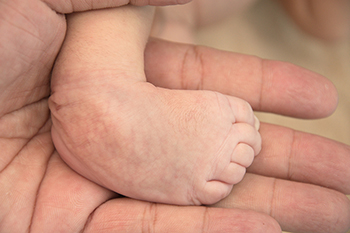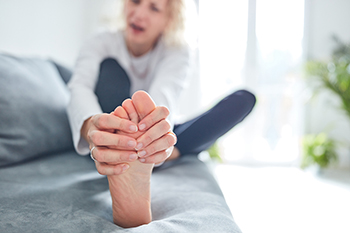Items filtered by date: December 2022
Congenital Foot Problems Can Be Corrected

Parents often count the number of their newborn’s toes and fingers, and in most cases, the number is normal. However, some babies are born with congenital foot problems, including clubfoot and a condition known as metatarsus adductus. The latter condition makes the foot look crooked as a result of a curve in the center. It can often be straightened out by a podiatrist if the foot is flexible and may improve naturally when the child is approximately 1 year old. Clubfoot is characterized by a stiff foot that turns inward at the time of birth. It can be diagnosed by an ultrasound while in the womb, and correction can be started soon after the baby is born. If your child is born with any type of abnormal foot condition, it is strongly suggested that you confer with a podiatrist who can help you with your baby’s progress.
Congenital foot problems require immediate attention to avoid future complications. If you have any concerns, contact one of our podiatrists of Quad Cities Foot and Ankle Associates. Our doctors can provide the care you need to keep you pain-free and on your feet.
Congenital foot problems are deformities affecting the feet, toes, and/or ankles that children are born with. Some of these conditions have a genetic cause while others just happen. Some specific foot ailments that children may be born with include clubfeet, polydactyly/macrodactyly, and cleft foot. There are several other foot anomalies that can occur congenitally. What all of these conditions have in common is that a child may experience difficulty walking or performing everyday activities, as well as trouble finding footwear that fits their foot deformity. Some of these conditions are more serious than others. Consulting with a podiatrist as early as possible will help in properly diagnosing a child’s foot condition while getting the necessary treatment underway.
What are Causes of Congenital Foot Problem?
A congenital foot problem is one that happens to a child at birth. These conditions can be caused by a genetic predisposition, developmental or positional abnormalities during gestation, or with no known cause.
What are Symptoms of Congenital Foot Problems?
Symptoms vary by the congenital condition. Symptoms may consist of the following:
- Clubfoot, where tendons are shortened, bones are shaped differently, and the Achilles tendon is tight, causing the foot to point in and down. It is also possible for the soles of the feet to face each other.
- Polydactyly, which usually consists of a nubbin or small lump of tissue without a bone, a toe that is partially formed but has no joints, or an extra toe.
- Vertical talus, where the talus bone forms in the wrong position causing other bones in the foot to line up improperly, the front of the foot to point up, and the bottom of the foot to stiffen, with no arch, and to curve out.
- Tarsal coalition, when there is an abnormal connection of two or more bones in the foot leading to severe, rigid flatfoot.
- Cleft foot, where there are missing toes, a V-shaped cleft, and other anatomical differences.
- Macrodactyly, when the toes are abnormally large due to overgrowth of the underlying bone or soft tissue.
Treatment and Prevention
While there is nothing one can do to prevent congenital foot problems, raising awareness and receiving neonatal screenings are important. Early detection by taking your child to a podiatrist leads to the best outcome possible.
If you have any questions please feel free to contact our offices located in Bettendorf, and DeWitt, IA and Rock Island, IL . We offer the newest diagnostic tools and technology to treat your foot and ankle needs.
Foot Pain Can Be Caused for Various Reasons

Many people experience foot pain at some point in their lives and it can cause difficulty in completing daily activities. There are several types of foot pain and a variety of causes, which is why patients often seek relief. Many people endure an injury that can result in a broken toe or ankle and recovery can take up to eight weeks. Heel pain can indicate that a heel spur or plantar fasciitis has developed which can happen from wearing shoes that do not fit correctly. Debilitating toe pain may be caused by gout and this occurs from having excess uric levels in the blood. Additionally, women who frequently wear high heels may develop a condition known as Morton’s neuroma which affects the nerve between the third and fourth toes. The lack of adequate room in the toe area may cause this nerve to become compressed and irritated, often making it difficult to walk. Any type of foot pain is treated by a podiatrist and it is strongly suggested that you speak with this type of doctor to find the relief you are seeking.
Foot Pain
Foot pain can be extremely painful and debilitating. If you have a foot pain, consult with one of our podiatrists from Quad Cities Foot and Ankle Associates. Our doctors will assess your condition and provide you with quality foot and ankle treatment.
Causes
Foot pain is a very broad condition that could be caused by one or more ailments. The most common include:
- Bunions
- Hammertoes
- Plantar Fasciitis
- Bone Spurs
- Corns
- Tarsal Tunnel Syndrome
- Ingrown Toenails
- Arthritis (such as Gout, Rheumatoid, and Osteoarthritis)
- Flat Feet
- Injury (from stress fractures, broken toe, foot, ankle, Achilles tendon ruptures, and sprains)
- And more
Diagnosis
To figure out the cause of foot pain, podiatrists utilize several different methods. This can range from simple visual inspections and sensation tests to X-rays and MRI scans. Prior medical history, family medical history, and any recent physical traumatic events will all be taken into consideration for a proper diagnosis.
Treatment
Treatment depends upon the cause of the foot pain. Whether it is resting, staying off the foot, or having surgery; podiatrists have a number of treatment options available for foot pain.
If you have any questions, please feel free to contact our offices located in Bettendorf, and DeWitt, IA and Rock Island, IL . We offer the newest diagnostic and treatment technologies for all your foot care needs.
Running and Flat Feet

People who have flat feet are often aware of how it can affect their running routine. The absence of an arch often does not absorb the shock of each step, and it may ultimately increase the risk of incurring an injury. One of the hazards of running with flat feet is overpronation, which is defined as the foot and arch rolling inward while landing. Patients who like to run often have their gait, or walking style analyzed, in addition to possibly wearing custom-made orthotics. It helps to know if you have flexible or rigid flat feet, and this can determine how the foot strikes the ground. Choosing stability or motion control running shoes may help to control overpronation by providing adequate support to the middle of the foot. If you have flat feet and enjoy running, it is strongly suggested that you are under the care of a podiatrist who can give you successful tips on how to possibly reduce the risk of injury while running.
Flatfoot is a condition many people suffer from. If you have flat feet, contact one of our podiatrists from Quad Cities Foot and Ankle Associates. Our doctors will treat your foot and ankle needs.
What Are Flat Feet?
Flatfoot is a condition in which the arch of the foot is depressed and the sole of the foot is almost completely in contact with the ground. About 20-30% of the population generally has flat feet because their arches never formed during growth.
Conditions & Problems:
Having flat feet makes it difficult to run or walk because of the stress placed on the ankles.
Alignment – The general alignment of your legs can be disrupted, because the ankles move inward which can cause major discomfort.
Knees – If you have complications with your knees, flat feet can be a contributor to arthritis in that area.
Symptoms
- Pain around the heel or arch area
- Trouble standing on the tip toe
- Swelling around the inside of the ankle
- Flat look to one or both feet
- Having your shoes feel uneven when worn
Treatment
If you are experiencing pain and stress on the foot you may weaken the posterior tibial tendon, which runs around the inside of the ankle.
If you have any questions please feel free to contact our offices located in Bettendorf, and DeWitt, IA and Rock Island, IL . We offer the newest diagnostic and treatment technologies for all your foot and ankle needs.
The Bones of the Feet

The feet are wonderfully complex parts of the human body. One thing that makes them so complex and interesting is the many different bones that are found in the foot. The feet are composed of 26 different bones that are located throughout the three main areas of the foot known as the hindfoot, the midfoot, and the forefoot. In the forefoot, five metatarsals and their phalanges make up the toes of the feet. These provide critical balancing services to the feet. The midfoot contains bones that are more irregular in shape than the forefoot. For example, in the midfoot, one can find bones such as the medial cuneiform, the lateral cuneiform, and the cuboid bone. Lastly, the hindfoot contains only two bones, the talus, and the calcaneus. Importantly, the calcaneus bone makes up the heel, or back of the foot. If you are interested in learning more about the many different bones of the foot, contact a podiatrist today for more information.
If you have any concerns about your feet, contact one of our podiatrists from Quad Cities Foot and Ankle Associates. Our doctors can provide the care you need to keep you pain-free and on your feet.
Biomechanics in Podiatry
Podiatric biomechanics is a particular sector of specialty podiatry with licensed practitioners who are trained to diagnose and treat conditions affecting the foot, ankle and lower leg. Biomechanics deals with the forces that act against the body, causing an interference with the biological structures. It focuses on the movement of the ankle, the foot and the forces that interact with them.
A History of Biomechanics
- Biomechanics dates back to the BC era in Egypt where evidence of professional foot care has been recorded.
- In 1974, biomechanics gained a higher profile from the studies of Merton Root, who claimed that by changing or controlling the forces between the ankle and the foot, corrections or conditions could be implemented to gain strength and coordination in the area.
Modern technological improvements are based on past theories and therapeutic processes that provide a better understanding of podiatric concepts for biomechanics. Computers can provide accurate information about the forces and patterns of the feet and lower legs.
Understanding biomechanics of the feet can help improve and eliminate pain, stopping further stress to the foot.
If you have any questions please feel free to contact our offices located in Bettendorf, and DeWitt, IA and Rock Island, IL . We offer the newest diagnostic and treatment technologies for all your foot and ankle needs.

